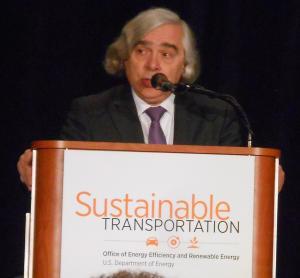by Joanne Ivancic (Advanced Biofuels USA) When it's called the "inaugral Sustainable Transportation Summit," you know the organizers anticipate more to come. Discussed for the past four years or so, the US Department of Transportation's Office of Energy Efficiency & Renewable Energy finally incorporated the vehicle and driver perspective into the annual Biomass (now Bioenergy) conference. Released from the bonds of "bio," this conference takes a broad view of current dreams and realities related to mobility, focusing on powering mobility with recognition of the vast expanse of other related infrastructure issues .
Secretary of Energy, Ernest J. Moniz--Opportunities and Disruptions: EVs competitive in six years
In his opening keynote, Secretary of Energy, Ernest J. Moniz repeated his intention to seek input for DOE from the approximately 500 participants at the conference. Input on reducing oil dependence, efficiency, energy security, the US auto industry (and its 1.5 million direct workers and 6-7 million indirect jobs) and renewable fuels and "nonfood-derived biofuels," lightweighting, technology innovation. He wants to hear more "blue sky" thinking about fundamental transformations.
Often that input can be garnered via Q&A periods with speakers, but none were included in the tightly scheduled program.
Although Moniz spoke mostly in generalities at this conference on sustainable transportation, he reiterated this administration's emphasis on "All of the Above" (meaning coal, petroleum and natural gas as well as renewables) even as he discussed, at length, COP21 climate change mitigation commitments and plans to "double down" on energy R&D investments. That seemed to include a reliance on nonprofits and on the private Mission Innovation programs rather than government spending. His mention of DOE's request for a 21% increase in energy R&D funds in the proposed Obama budget was met with laughter from the audience and a smirk from Moniz.
Regardless, Moniz expects electric vehicles to be competitive with gasoline-powered vehicles in six years.
He noted that this would develop in tandem with the Co-Optima initiative, developing biofuels and engine innovations together, apparently recognizing (unlike some other speakers) that for decades into the future we will have millions of internal combustion engines on the roads.
Ken Washington Ford Motor Company-Research & Advanced Engineering--with Real People
Ken Washington reported on Ford's approach to innovation; identifying the pain and experimenting with what could work, what does not work, to alleviate that pain.
Digital interconnectedness (ultra connected lives) and need for flexible use and ownership models are key to experiments with multi-modal mobility. Key words: affordable, convenient, great experience.
The Dynamic Shuttle is designed for shared experiences. It goes where you want to go at the click of a button, provides a shared ride that lowers your price but doesn't inconvenience you. The interior has USB plugs, bright lighting, space. It's being prototyped at Dearborn with Ford employees trying it out and fine tuning the experience providing immediate, efficient, knowedgeable feedback.
Another experiment is GoRide with a smaller footprint vehicle than public buses to provide a better experience for the consumer.
And, experimenting with the ultimate in bio-power, the Info Cycle, a pedal bicycle outfitted with sensors and monitors that provide data on where people travel, when and how. Information that can be incorporated into the multi-modal system.
Washington anticipates Level 4 Autonomous Vehicles (hand on wheel) on the market within four years. Path-finding algorithms and other technologies continue to be developed, with testing now at proving grounds in Arizona; plus snow testing.
In the near term Ford will add 13 new electric vehicles to its lineup by 2020.
Bits and Pieces from Presentations and Panel Discussions
Former Michigan Governor, Jennifer M. Granholm: Barriers to EVs batteries, range anxiety, places to charge. It's about jobs. For every part, there is a part supplier and people whose job it is to make that part. How to get EVs to get past being chichi on the coasts. What is the policy pathway for EVs to become a person's first car?
Dan Sperling, UC Davis Institute of Transportation Studies: Amazed at the tension between scientists, academic and regulators in trying to make things happen. We understand the options to get to 80% lower emissions--no need for breakthrough technologies for light duty vehicles. Heavy trucks, aviation more complicated. Long haul batteries won't work. Probably biofuels and hydrogen fuels. Aviation needs biofuels. We need to think about how to get these biofuels that we need. Low carbon and low cost.
Anthony Eggert, CimateWorks Foundation: Introduced importance of behavior change to vehicle demand. Noted in Copenhagen--50% trips are by bike because it's convenient, safe, fun, easy to get around by that mode. "Total cost of ownership" has to be unsubsidized (through the valley of death), and convenient. Most people don't know EVs exist--if know, they may have heard of Prius.
Question of the Day: What gets people to buy EVs?
AE: Even in California, wit lots of incentives, market penetration of EVs is still only 3%. Consumers are very conservative, reluctant. Only 13% had even vague sense of what is available in EVs. Compare to Norway at 30% penetration for electric and PHEV. They are now normal. Problem could be that lots of models available are only compact and subcompact--not yet SUVs.
Granholm noted that she drives a Volt and even though it has an internal combustion engine for extended range, she is motivated to use just electric charge. As Eggert noted, the Volt is like a gateway drug to a just plug-in electric car.
What is the role of policy in pushing adoption?
DS: We have about the best policy we can imagine--CAFE standards going to 54.5 MPG by 2022. So engineers have improved light weight materials, efficient engines. Also, California and nine other states have Zero Emission requirement, meeting a need to have regulatory certainty. ZEV; FEEBATE. Challenge is that regulations and market signals are out of alignment. The low price of gasoline makes convincing people to change even harder.
FEEBATE: Buy a gas guzzler--pay a fee. This finances rebates to those who buy efficient vehicles.
In this and other discussions of FEEBATE, no mention was made of the possibility that gas guzzlers might be using low carbon emissions, low air pollution emitting biofuels.
This group generally had a pessimistic view of the potential for carbon tax to levels needed to achieve desired change.
JG: Most states chafe at price on carbon.
AE: There's inertia in the system. Carrot focus now.
This group brought up a topic revisited a number of times during the day, then need to align research agendas to support technology innovations, with EERE looking at what does it take to get into marketplace, to help cultivate the ecosystem to make this transition to EVs successful.
Need for federal involvement?
AE: Initially yes; eventually has to be private-sector driven.
JG: Paying for electrification of entire system.
AE: Can't rely on federal government to electrify the system. It does need to be profitable with dividends to public and private sectors.
DS: DOE and feds looking more at funding programs to states and cities.
JG: Federal role in assuring interoperability of charging stations.
DS: Partnerships with utilities. Include hydrogen.
JG: techology pathways?
DS: We need better biofuels for aviation. Need to focus on that. Made mistakes on policy side--not enough investment. Most R&D is private sector. Policy becomes crucial to make sure the innovation and investments happen.
AE: Even petroleum is sun-derived
Behavior--when will people accept the technology?
AE: Acceptance of technology will be immediate once people get into these Levels 4-5 autonomous vehicles.
DS: There is a risk of 0 occupancy vehicles resulting in more VMT (vehicle miles traveled); car driving around to avoid parking fees, etc.
DS: California developed a suite of policies. It would be nice to have a carbon tax; but we can't get the carbon price we need, so we need the other things; need to be clever, coordinate. Still, even California doesn't do aviation and shipping policies. And some misaligned policies--a carbon target for metro areas, but no financial rewards. We should restructure funding to reward cities. As it is, more vehicle use qualifies for more money.
Eric Toone Vice Provost and Professor of Chemistry Director, Duke Innovation and Entrepreneurship Initiative Duke University, in a very dense presentation, reviewed multiple way to power mobility and highlighted the drawbacks of each.
Essentially, what liquid fuels have going for them are energy density, easy of handling and need to power existing 1Billion gasoline/diesel cars on roads, even though, cost of petroleum carbon adds 37 cents to cost of gallon of gasoline.
Some techniques critiqued:
- Direct air capture.
- Carbon capture from point sources and dilute sources.
- FT from syngas
- Sources of Hydrogen, Renewable hydrogen needed for fuel cells or some hydrocarbon fuel production
- Water splitting
- Electricity-based Fuel Prodution
- ElectroChemical Reduction of CO2
- Thermochemical Reduction of water to split to
- Photocatalytic Reduction of CO2
- Direct solar fuel program. to get H
- Photons gathered by plants for Biofuels
Net-Zero Carbon Fuels
 From left, Mark Johnson (DOE ARPA-E), Harry Atwater (JCAP), Jennifer Holmgren (LanzaTech), Kathy Ayers (Proton Onsite)
From left, Mark Johnson (DOE ARPA-E), Harry Atwater (JCAP), Jennifer Holmgren (LanzaTech), Kathy Ayers (Proton Onsite)
Mark Johnson, US Department of Energy ARPA-E in his opening remarks reviewed the original bio-based fuels--horses; commented on the use of land to grow the feedstock and the attendant methane problem.
This panel illustrated a number of the practical aspects of moving into sustainable transportation. Most presenters during the day presented from the perspective of what one attendee called "a fantastical world," detached from everyday reality.
LanzaTech CEO, Jennifer Holmgren and Proton Onsite VO for Research and Development, Kathy Ayers, seemed to have the most down-to-earth, practical perspectives. Perhaps because they represented industries and had personally struggled with getting new technologies into commercial markets. Their presence highlighted the difference between academic and government dreamers and industrial dreamers. Both urged more communication among "silos".
Ayers, with her participation on the board of the Joint Center for Artificial Photoshythesis (JCAP), represented on the panel by its director, Harry Atwater, mentioned the ability for industry to bring perspectives and to raise questions that aren't usually addressed without industry involvement in these kinds of centers.
Holmgren's description of how successful building of the Lanza Tech syngas fermentation process requires breaking down of many silos--not only process and chemical engineers, but an understanding of the needs of an industrial biological process, a process of living organisms that, unlike straight chemical or physical processes, have the wonderful ability to do multiple, varied tasks. For example, they adjust to the amount of hydrogen in their environment; they use carbon not only to make their end products, but also to grow and reproduce. The purpose of the engineers is to make, monitor and operate an environment in which these micro-organic divas can thrive. As is true for much development in new, never-been-done-before technologies, they "allow learning from other industries."
When you have presenters talking about how inefficient plants are due to their inability to convert every photon that hits their leaves into stored energy, as if that is the only use of photons and the only measure of efficient use of them..., the scale of the challenge of achieving any progress toward sustainable mobility becomes clear.
Holmgren also explained the financial conundrum. Build quickly. There are so many technologies available. As soon as you get the first commercial built, you can drive down costs. First you need to get through the Grand Canyon of Death. It is so hard to get first commercial scale when it requires a $100 million production facility with NO certainty that it will work. (Remember, there are never-been-done-before innovations, not just tweaks of existing technologies.) Still have to match with risk capital. Need to get as many from lab to demo to commercial as we can.
Atwater finished with optimism, about people coming together, especially next generation scientists, excited students at JCAP. He is optimistic about the future because of the human workforce, represented by the heavily over-subscribed applications to work on renewable energy science at JCAP.
John Davis Motorweek, vehicle to vehicle communication
John Davis also brought some real-world perspective to the conversation, real-world things like laws, regulations, liability concerns, questions of how to program values into autonomous vehicles.
For example he asked if we should teach cars to drive like we drive or according to all laws and regulations. Who really obeys traffic speed limits at all times?
And what about choices we make in emergencies? Should we/the car swerve around a pedestrian to hit tree and possibly injure or kill everyone in the car, or hit the pedestrian?
He reiterated the usual promises of potential for car-sharing, saving fuel, alleviating congestion with autonomous cars. But wants us to focus on if in the near-term they will force us to become better drivers.
So much has been done under the hood already to improve efficiency: power trains, advanced technology, direct fuel injection, electropower steering, turbocharging, smaller aluminum engines. These are mostly unknown by most customers. However, it feels good and makes them happy.
Even diesels have improved so much they are not distinguishable by regular consumers.
And we already enjoy more electrification in vehicles--not fully but more than just steering. Auto stop/start. Mild hybrids. Hanger-on electric motor with higher voltage than previous GM attempts. More umph getting off the line. EVs have barriers--cost, range, etc., so in the short term we'll go for incremental steps that are affordable to consumers. He projects that in 5-7 years all new cars will have some electrical assist.
Davis moderated "Fireside Chat #3: What moves people to adopt?" with Vassilis Papayannoulis of Urban Analytics, Metropia; Maya Shankar, the White House Office of Science and Technology Policy's Senior Advisor on Behavioral Science and Mary Beth Stanek, General Motors' Director of Vehicle Technologies and Government Relations.
They discussed today's increasing mobility options and how to change travel behavior. Papayannoulis , speaking from a New York City perspective suggested the path was to discover what motivates people, engage them, and collect data in order to integrate options.
Stanek suggested a key question is whether advanced technologies have any use for customers. She said that there must be a benefit and it cannot be too different from what they do today. Studies show that if they prefer gasoline engines, the are probably going to remain with them. The reason, however, is not clear. Is this related to affordable gas and diesel or just about familiarity?
A question for the group: Considering price increases related to advanced technologies. What to do to get consumers not to rebel, to embrace, accept? Can we anticipate hitting a wall by 2020 especially if there's a downturn in the economy?
Step-by-step changes seem to be the practical progression with autonomy-related safety features being incorporated already; although Papayannoulis suggested that places without subway/mass transit alternatives might have an easier time making radical changes.
MS: Convening thought leaders is important. Challenge to convince people of the value of increased costs today for long term returns. Need to better articulate long term benefits. Make salient gains that you can feel in the moment.
MBS: Deep mapping, incorporating short-wave frequency will make difference in making change happen.
MS: Two suggestions: Simulate feeling of agency (control of the vehicle). Learn from project in Bangladesh: where, after researching why people didn't use public transportation, created a mobile app that tells location of buses, and whether they are full or have room so potential riders can make informed decisions. User-centered design.
MBS: Octane fuel in EU higher octane. Consumers have choice of brands, sizes. Others need to support the transition. It can't be just on the back of the automakers.
Amory Lovins Rocky Mountain Institute Moving to the Age of Silicon
Physicist Amory Lovins, cofounder and Chief Scientist of the Rocky Mountain Institute compared the changes today in mobility to the magnitude of change between typewriters and computers. Claiming that incrementalism (as discussed in previous panels) will not get us there, Lovins looks to electrification supported by FEEBATES as the answer to rapid, revolutionary mobility innovation as seen in France and Norway.
He applauds China's adoption of electric vehicles (but does not mention the high polluting coal plants as the source of power).
He presents the SR-71 Blackbird as an example of the leap into the future that we should emulate (but fails to note that this most beautiful kinetic sculpture, this unbelievably successful military aircraft, this fastest plane in the world no longer flies and has been mothballed and relegated to museum displays).
Looking at new mobility business models to effectuate his belief that future will be full of shared autonomous vehicles. He looks to designing cities "for feet, not cars;" to mover from super boulevards to a web of streets, from superblocks to walking distances to achieve driving two thirds less for the same services.
He did admit that we need to reach efficiency with more productive use, with hydrogen fuel cells and advanced biofuels. He envisions fuels made two thirds from waste without displacing cropland or harming air or soil. And with value exceeding price which must exceed cost.
It's elemental: moving from the age of carbon to the age of silicon.
Nearly 55,000 articles in our online library!
Use the categories and tags listed below to access the nearly 50,000 articles indexed on this website.
Advanced Biofuels USA Policy Statements and Handouts!
- For Kids: Carbon Cycle Puzzle Page
- Why Ethanol? Why E85?
- Just A Minute 3-5 Minute Educational Videos
- 30/30 Online Presentations
- “Disappearing” Carbon Tax for Non-Renewable Fuels
- What’s the Difference between Biodiesel and Renewable (Green) Diesel? 2020 revision
- How to De-Fossilize Your Fleet: Suggestions for Fleet Managers Working on Sustainability Programs
- New Engine Technologies Could Produce Similar Mileage for All Ethanol Fuel Mixtures
- Action Plan for a Sustainable Advanced Biofuel Economy
- The Interaction of the Clean Air Act, California’s CAA Waiver, Corporate Average Fuel Economy Standards, Renewable Fuel Standards and California’s Low Carbon Fuel Standard
- Latest Data on Fuel Mileage and GHG Benefits of E30
- What Can I Do?
Donate
DonateARCHIVES
- December 2025
- November 2025
- October 2025
- September 2025
- August 2025
- July 2025
- June 2025
- May 2025
- April 2025
- March 2025
- February 2025
- January 2025
- December 2024
- November 2024
- October 2024
- September 2024
- August 2024
- July 2024
- June 2024
- May 2024
- April 2024
- March 2024
- February 2024
- January 2024
- December 2023
- November 2023
- October 2023
- September 2023
- August 2023
- July 2023
- June 2023
- May 2023
- April 2023
- March 2023
- February 2023
- January 2023
- December 2022
- November 2022
- October 2022
- September 2022
- August 2022
- July 2022
- June 2022
- May 2022
- April 2022
- March 2022
- February 2022
- January 2022
- December 2021
- November 2021
- October 2021
- September 2021
- August 2021
- July 2021
- June 2021
- May 2021
- April 2021
- March 2021
- February 2021
- January 2021
- December 2020
- November 2020
- October 2020
- September 2020
- August 2020
- July 2020
- June 2020
- May 2020
- April 2020
- March 2020
- February 2020
- January 2020
- December 2019
- November 2019
- October 2019
- September 2019
- August 2019
- July 2019
- June 2019
- May 2019
- April 2019
- March 2019
- February 2019
- January 2019
- December 2018
- November 2018
- October 2018
- September 2018
- August 2018
- July 2018
- June 2018
- May 2018
- April 2018
- March 2018
- February 2018
- January 2018
- December 2017
- November 2017
- October 2017
- September 2017
- August 2017
- July 2017
- June 2017
- May 2017
- April 2017
- March 2017
- February 2017
- January 2017
- December 2016
- November 2016
- October 2016
- September 2016
- August 2016
- July 2016
- June 2016
- May 2016
- April 2016
- March 2016
- February 2016
- January 2016
- December 2015
- November 2015
- October 2015
- September 2015
- August 2015
- July 2015
- June 2015
- May 2015
- April 2015
- March 2015
- February 2015
- January 2015
- December 2014
- November 2014
- October 2014
- September 2014
- August 2014
- July 2014
- June 2014
- May 2014
- April 2014
- March 2014
- February 2014
- January 2014
- December 2013
- November 2013
- October 2013
- September 2013
- August 2013
- July 2013
- June 2013
- May 2013
- April 2013
- March 2013
- February 2013
- January 2013
- December 2012
- November 2012
- October 2012
- September 2012
- August 2012
- July 2012
- June 2012
- May 2012
- April 2012
- March 2012
- February 2012
- January 2012
- December 2011
- November 2011
- October 2011
- September 2011
- August 2011
- July 2011
- June 2011
- May 2011
- April 2011
- March 2011
- February 2011
- January 2011
- December 2010
- November 2010
- October 2010
- September 2010
- August 2010
- July 2010
- June 2010
- May 2010
- April 2010
- March 2010
- February 2010
- January 2010
- December 2009
- November 2009
- October 2009
- September 2009
- August 2009
- July 2009
- June 2009
- May 2009
- April 2009
- March 2009
- February 2009
- January 2009
- December 2008
- November 2008
- October 2008
- September 2008
- August 2008
- July 2008
- June 2008
- May 2008
- April 2008
- March 2008
- February 2008
- January 2008
- December 2007
- November 2007
- October 2007
- September 2007
- August 2007
- June 2007
- February 2007
- January 2007
- October 2006
- April 2006
- January 2006
- April 2005
- December 2004
- November 2004
- December 1987
CATEGORIES
- About Us
- Advanced Biofuels Call to Action
- Aviation Fuel/Sustainable Aviation Fuel (SAF)
- BioChemicals/Renewable Chemicals
- BioRefineries/Renewable Fuel Production
- Business News/Analysis
- Cooking Fuel
- Education
- 30/30 Online Presentations
- Competitions, Contests
- Earth Day 2021
- Earth Day 2022
- Earth Day 2023
- Earth Day 2024
- Earth Day 2025
- Executive Training
- Featured Study Programs
- Instagram TikTok Short Videos
- Internships
- Just a Minute
- K-12 Activities
- Mechanics training
- Online Courses
- Podcasts
- Scholarships/Fellowships
- Teacher Resources
- Technical Training
- Technician Training
- University/College Programs
- Events
- Coming Events
- Completed Events
- More Coming Events
- Requests for Speakers, Presentations, Posters
- Requests for Speakers, Presentations, Posters Completed
- Webinars/Online
- Webinars/Online Completed; often available on-demand
- Federal Agency/Executive Branch
- Agency for International Development (USAID)
- Agriculture (USDA)
- Commerce Department
- Commodity Futures Trading Commission
- Congressional Budget Office
- Defense (DOD)
- Air Force
- Army
- DARPA (Defense Advance Research Projects Agency)
- Defense Logistics Agency
- Marines
- Navy
- Education Department
- Energy (DOE)
- Environmental Protection Agency
- Federal Energy Regulatory Commission (FERC)
- Federal Reserve System
- Federal Trade Commission
- Food and Drug Administration
- General Services Administration
- Government Accountability Office (GAO)
- Health and Human Services (HHS)
- Homeland Security
- Housing and Urban Development (HUD)
- Interior Department
- International Trade Commission
- Joint Office of Energy and Transportation
- Justice (DOJ)
- Labor Department
- National Academies of Sciences Engineering Medicine
- National Aeronautics and Space Administration
- National Oceanic and Atmospheric Administration
- National Research Council
- National Science Foundation
- National Transportation Safety Board (NTSB)
- Occupational Safety and Health Administration
- Overseas Private Investment Corporation
- Patent and Trademark Office
- Securities and Exchange Commission
- State Department
- Surface Transportation Board
- Transportation (DOT)
- Federal Aviation Administration
- National Highway Traffic Safety Administration (NHTSA)
- Pipeline and Hazardous Materials Safety Admin (PHMSA)
- Treasury Department
- U.S. Trade Representative (USTR)
- White House
- Federal Legislation
- Federal Litigation
- Federal Regulation
- Feedstocks
- Agriculture/Food Processing Residues nonfield crop
- Alcohol/Ethanol/Isobutanol
- Algae/Other Aquatic Organisms/Seaweed
- Atmosphere
- Carbon Dioxide (CO2)
- Field/Orchard/Plantation Crops/Residues
- Forestry/Wood/Residues/Waste
- hydrogen
- Manure
- Methane/Biogas
- methanol/bio-/renewable methanol
- Not Agriculture
- RFNBO (Renewable Fuels of Non-Biological Origin)
- Seawater
- Sugars
- water
- Funding/Financing/Investing
- grants
- Green Jobs
- Green Racing
- Health Concerns/Benefits
- Heating Oil/Fuel
- History of Advanced Biofuels
- Infrastructure
- Aggregation
- Biofuels Engine Design
- Biorefinery/Fuel Production Infrastructure
- Carbon Capture/Storage/Use
- certification
- Deliver Dispense
- Farming/Growing
- Precursors/Biointermediates
- Preprocessing
- Pretreatment
- Terminals Transport Pipelines
- International
- Abu Dhabi
- Afghanistan
- Africa
- Albania
- Algeria
- Angola
- Antarctica
- Arctic
- Argentina
- Armenia
- Aruba
- Asia
- Asia Pacific
- Australia
- Austria
- Azerbaijan
- Bahamas
- Bahrain
- Bangladesh
- Barbados
- Belarus
- Belgium
- Belize
- Benin
- Bermuda
- Bhutan
- Bolivia
- Bosnia and Herzegovina
- Botswana
- Brazil
- Brunei
- Bulgaria
- Burkina Faso
- Burundi
- Cambodia
- Cameroon
- Canada
- Caribbean
- Central African Republic
- Central America
- Chad
- Chile
- China
- Colombia
- Congo
- Congo, Democratic Republic of
- Costa Rica
- Croatia
- Cuba
- Cyprus
- Czech Republic
- Denmark
- Dominican Republic
- Dubai
- Ecuador
- El Salvador
- Equatorial Guinea
- Eqypt
- Estonia
- Eswatini/Swaziland
- Ethiopia
- European Union (EU)
- Fiji
- Finland
- France
- French Guiana
- Gabon
- Georgia
- Germany
- Ghana
- Global South
- Greece
- Greenland
- Grenada
- Guatemala
- Guinea
- Guyana
- Haiti
- Honduras
- Hong Kong
- Hungary
- Iceland
- India
- Indonesia
- Iran
- Iraq
- Ireland
- Israel
- Italy
- Ivory Coast
- Jamaica
- Japan
- Jersey
- Jordan
- Kazakhstan
- Kenya
- Korea
- Kosovo
- Kuwait
- Laos
- Latin America
- Latvia
- Lebanon
- Liberia
- Lithuania
- Luxembourg
- Macedonia
- Madagascar
- Malawi
- Malaysia
- Maldives
- Mali
- Malta
- Marshall Islands
- Mauritania
- Mauritius
- Mexico
- Middle East
- Moldova
- Monaco
- Mongolia
- Morocco
- Mozambique
- Myanmar/Burma
- Namibia
- Nepal
- Netherlands
- New Guinea
- New Zealand
- Nicaragua
- Niger
- Nigeria
- North Africa
- North America
- North Korea
- Northern Ireland
- Norway
- Oman
- Pakistan
- Panama
- Papua New Guinea
- Paraguay
- Peru
- Philippines
- Poland
- Portugal
- Qatar
- Republic of
- Romania
- Russia
- Rwanda
- Saudi Arabia
- Scotland
- Senegal
- Serbia
- Sierra Leone
- Singapore
- Slovakia
- Slovenia
- Solomon Islands
- South Africa
- South America
- South Korea
- South Sudan
- Southeast Asia
- Spain
- Sri Lanka
- Sudan
- Suriname
- Sweden
- Switzerland
- Taiwan
- Tanzania
- Thailand
- Timor-Leste
- Togo
- Trinidad and Tobago
- Tunisia
- Turkey
- Uganda
- UK (United Kingdom)
- Ukraine
- United Arab Emirates UAE
- Uruguay
- Uzbekistan
- Vatican
- Venezuela
- Vietnam
- Wales
- Zambia
- Zanzibar
- Zimbabwe
- Marine/Boat Bio and Renewable Fuel/MGO/MDO/SMF
- Marketing/Market Forces and Sales
- Opinions
- Organizations
- Original Writing, Opinions Advanced Biofuels USA
- Policy
- Presentations
- Biofuels Digest Conferences
- DOE Conferences
- Bioeconomy 2017
- Bioenergy2015
- Biomass2008
- Biomass2009
- Biomass2010
- Biomass2011
- Biomass2012
- Biomass2013
- Biomass2014
- DOE Project Peer Review
- Other Conferences/Events
- R & D Focus
- Carbon Capture/Storage/Use
- Co-Products
- Feedstock
- Logistics
- Performance
- Process
- Vehicle/Engine/Motor/Aircraft/Boiler/Ship
- Yeast
- Railroad/Train/Locomotive Fuel
- Resources
- Books Web Sites etc
- Business
- Definition of Advanced Biofuels
- Find Stuff
- Government Resources
- Scientific Resources
- Technical Resources
- Tools/Decision-Making
- Rocket/Missile Fuel
- Sponsors
- States
- Alabama
- Alaska
- Arizona
- Arkansas
- California
- Colorado
- Connecticut
- Delaware
- Florida
- Georgia
- Hawai'i
- Idaho
- Illinois
- Indiana
- Iowa
- Kansas
- Kentucky
- Louisiana
- Maine
- Maryland
- Massachusetts
- Michigan
- Midwest
- Minnesota
- Mississippi
- Missouri
- Montana
- Native American tribal nation lands
- Nebraska
- Nevada
- New Hampshire
- New Jersey
- New Mexico
- New York
- North Carolina
- North Dakota
- Ohio
- Oklahoma
- Oregon
- Pennsylvania
- Puerto Rico
- Rhode Island
- South Carolina
- South Dakota
- Tennessee
- Texas
- Utah
- Vermont
- Virginia
- Washington
- Washington DC
- West Coast
- West Virginia
- Wisconsin
- Wyoming
- Sustainability
- Uncategorized
- What You Can Do
tags
© 2008-2023 Copyright Advanced BioFuels USA. All Rights reserved.






.jpg)





0 COMMENTS
Leave A Comment
Your Email Address wiil not be Published. Required Field Are marked*